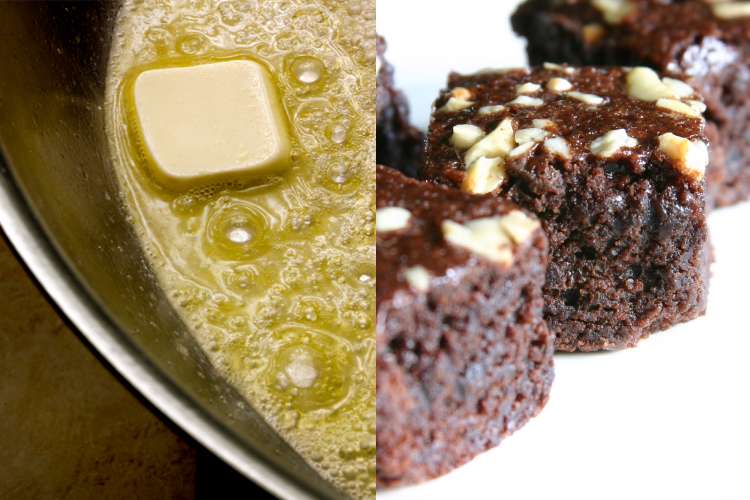Modified from Alice Medrich, published in Bon Appetit, Feb. 2011
Makes 16 brownies
Ingredients
- 2½ sticks of unsalted butter (Don’t freak out! You’ll only really use half of it.)
- 1 cup sugar
- ¾ cup unsweetened cocoa powder (you’d be amazed at how much difference there is in cocoa powders; get a good quality one)
- ¼ teaspoon salt
- 1 teaspoon vanilla extract
- 2 teaspoons water
- 2 large eggs, cold
- 1/3 cup plus 1 tablespoon all-purpose flour
- 1 cup walnuts, lightly toasted
Directions
- Preheat oven to 325 F.
- Line an 8×8-inch baking pan with aluminum foil, pressing it into the corners of the pan, and leaving a couple inches of overhang. (You’re going to use this to lift the brownies out later. Genius! This is what you get for using recipes written by real professionals.) Rub a little butter over the foil to grease it.
- Melt and brown butter, as described below*.
- While the butter is still in the early stages of cooking, combine the sugar, cocoa and salt in a fairly heatproof bowl.
- Have a second heatproof cup or bowl ready. When the milk solids are beautifully browned, either pour or scoop out ½ cup (8 tablespoons) of the butter into that cup, being careful to keep all the browned bits with you in the pan. Then all at once dump the butter from the pan into the bowl with the cocoa mixture. Scrape in all the browned bits stuck to the pan, unless they’re burnt. Add the vanilla and water, and stir to blend. It will come together like rough concrete. The mixture should be fairly hot; let cool for 5 minutes. (You get to keep the extra butter for other uses; store in fridge.)
- Beat in one of the eggs vigorously. It will look horrible. The butter will probably separate out of the cocoa/sugar mass, and it will start to make you very sad. About now, you will be cursing. Beat in the second egg, though, and watch it all come back together. Egg saves the day!
- When your mixture looks shiny and uniform, add the flour and stir until blended. The recipe continues: “Beat vigorously 60 strokes.” And seriously, they’re not kidding. As you work it, the gluten will develop in the flour and make it firmer and tougher. Just take a breath, hold on and crank it.
- Stir in the nuts, and scrape the batter into the baking pan. Bake 25 minutes, or until a toothpick in the center comes out not quite clean (there should be a few moist crumbs sticking to it). Cool the pan on a rack, then lift the brownies out with the foil. Cut into four strips, and quarter those to make 16 brownies.
* The safest way I’ve found to do it is this: Put a heavy, light-colored pan over medium heat. (Black-bottomed or nonstick pans make it hard to see the color.) Cut the butter into one-inch pieces, so that they melt and color evenly — you don’t want a big lump of butter still sliding around solid while stuff is already burning around it.
If you’re using just a small amount of butter, there’s really no mystery. Just let it get hot, foam and settle, and keep a close eye on the color of the milk solids at the bottom. Like caramel, the darker they are, the more complex the flavor, but the jump from dark to burnt is a shockingly quick one, so err on the side of safety. If you’re using this is as a sauce, add your lemon juice or capers or whatever else immediately, as it will help to cool it down and set the color.
But if you’re using a larger amount of Paula Deen’s best friend — as in the recipe above — you can work it a little more precisely. I like to use a lower heat, more medium to medium-low, to get a nice even color. As the water in the butter eventually comes to bubble up and boil, be careful — it has a tendency to splatter. Gently swirl the pan, so that those bubbles dissipate a bit, and use a heatproof rubber spatula or spoon to clean up any early-browning bits along the side of the pan. (Don’t throw them out — just start adding them to whatever you’re going to put the butter on or in.) Stir often while cooking. Eventually, you’ll cook off the water, the milk solids will settle at the bottom, and the foamy proteins will look like a scum at the surface. You can skim it, if you’d like.
At this point, what you’re doing is clarifying the butter, and if you keep the heat pretty low, all the water will eventually evaporate without the milk solids browning. What you’ll be left with is crystal-clear pure butterfat. (It’s great for sautéing and high-heat cooking that you can’t normally do with butter.)
But let it keep going on the flame, and the solids will brown after a few minutes. Watch the pan. Once they turn a medium brown color, take them off; they’ll keep coloring from the residual heat.

